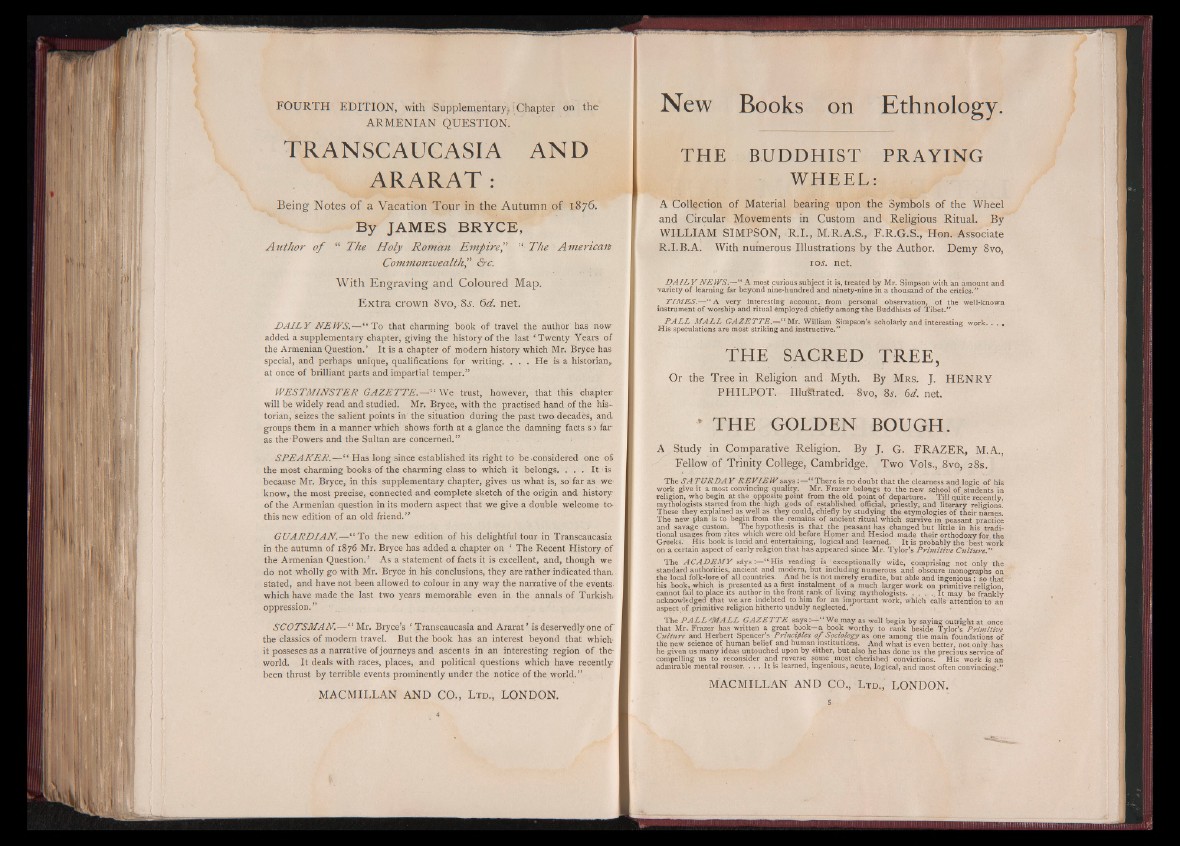
FOURTH EDITION, with Supplementary;; i Chapter on the
ARMENIAN QUESTION.
TRANSCAUCASIA AND
ARARAT:
Being Notes of a Vacation Tour in the Autumn of 1876.
By JAMES BRYCE,
Author o f “ The Holy Roman E m p i r e “ The American
Commonwealth&c.
With Engraving and Coloured Map.
Extra crown 8vo, 8j. 6d. net.
DAILY NEWS.— “ To that charming book of travel the author has now-
added a supplementary chapter, giving the history of the last ‘ Twenty Years of
the Armenian Question.’ It is a chapter of modern history which Mr. Bryce has
special, and perhaps unique, qualifications for writing. . . . He is a historian,
at once of brilliant parts and impartial temper.”
WESTMINSTER GAZETTE.— :! We trust, however, that this chapter!
will be widely read and studied. Mr. Bryce, with the practised hand of the historian,
seizes the salient points in the situation during the past two decades, and
groups them in a manner which shows forth at a glance the damning facts sr far
as the'Powers and the Sultan are concerned.”
SPEAKER.— “ Has long since established its right to be considered one of
the most charming books of the charming class to which it belongs. . . . It is
because Mr. Bryce, in this supplementary chapter, gives us what is, so far as we
know, the most precise, connected and complete sketch of the origin and history
of the Armenian question in its modern aspect that we give a double welcome to-
this new edition of an old friend. ”
GUARDIAN.— “ To the new edition of his delightful tour in Transcaucasia
in the autumn of 1876 Mr. Bryce has added a chapter on ‘ The Recent History of
the Armenian Question. ’ As a statement of facts it is excellent, and, though we
do not wholly go with Mr. Bryce in his conclusions, they arefather indicated than,
stated, and have not been allowed to colour in any way the narrative of the events,
which have made the last two years memorable even in the annals of Turkish,
oppression. ”
SCOTSMAN.— “ Mr. Bryce’s ‘ Transcaucasia and Ararat ’ is deservedly one of'
the classics of modern travel. But the book has an interest beyond that which
it posseses as a narrative of journeys and ascents in an interesting region of the
world. It deals with races, places, and political questions which have recently-
been thrust by terrible events prominently under the notice of the world.”
New Books on Ethnology.
THE BUDDHIST PR A Y ING
WHEEL:
A Collection of Material bearing upon the Symbols of the Wheel
and Circular Movements in Custom and Religious Ritual. By
WILLIAM SIMPSON, R.I., M.R.A.S., F.R.G.S., Hon. Associate
R.I.B.A. With numerous Illustrations by the Author. Demy 8vo,
roi. net.
DAILY NEWS“ A most curious subject it is, treated by Mr. Simpson with an amount and
variety of learning far beyond nine-hundred and ninety-nine in a thousand of the critics.”
TIMES.—“ A very interesting account, from personal observation, of the well-known
instrument of worship and ritual employed chiefly among the Buddhists of Tibet.”
PALL MALL GAZETTE.—“ Mr. William Simpson’s scholarly and interesting work. . . .
His speculations are most striking and instructive.”
THE SACRED TREE,
Or the Tree in Religion and Myth. By Mrs. J. H ENRY
PHILPOT. Illustrated. 8vo, 8r. 6d. net.
* THE GOLDEN BOUGH.
A Study in Comparative Religion. By J. G. FRAZER, M.A.,
Fellow of Trinity College, Cambridge. Two Vols., 8vo, 28s.
The SATURDAY REVIEW says :—“ There is no doubt that the clearness and logic of his
work give it a most convincing quality. Mr. Frazer belongs to the new school of students in
religion, who begin at the opposite point from the old point of departure. Till quite recently,
my thologists started from the high gods of established official, priestly, and literary religions.
These they explained as well as they could, chiefly by studying the etymologies of their names.
The new plan is to begin from the remains of ancient ritual which survive in peasant practice
and savage custom. The hypothesis is that the peasant has changed but little in his traditional
usages from rites which were old_ before Homer and Hesiod made their orthodoxy for, the
Greeks. His book is lucid and entertaining, logical and learned. It is probably the best work
on a certain aspect of early religion that has appeared since Mr. Tylor’s Primitive Culture.”
The ACADEMY sáys :—“ His reading is exceptionally wide, comprising not only the
standard authorities, ancient and modern, but including numerous and obscure monographs on
the local folk-lore of all countries. And_ he is not merely erudite, but able and ingenious ; so that
his book, which is presented as a first instalment of a much larger work on primitive religion,
cannot fail to place its author in the front rank of living my thologists............ .I t may be frankly
acknowledged that we are indebted to him for an important wórk, which calls attention to an
aspect of primitive religion hitherto unduly neglected.”
The PALL-MALL GAZETTE says:— “ We may as well begin by saying outright at once
that Mr. Frazer has written a great book—a book worthy to rank beside Tylor’s Primitive
Culture and Herbert Spencer’s Principles of Sociology as one among the main foundations of
the new science of human belief and human institutions. And what is even better, not. only has
he given us many ideas untouched upon by either, but also he has done us the precious service of
compelling us to reconsider and reverse some most cherished coñvictions. His work is an
admirable mental rouser. . . . It is learned, ingenious, acute, logical, and most often convincing.”
MA.CMILLAN AND CO., L td ., LONDON.